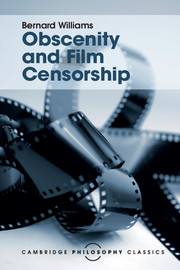3 - The censorship of films
from Part 1 - Background
Published online by Cambridge University Press: 05 November 2015
Summary
The legal basis of the censorship system
3.1 Parliament has never legislated for the censorship of films: it is purely a matter of accident that the film censorship system was able to find some statutory support when it first struggled into existence just before the First World War. Although the system has for many years been taken for granted, it had very uncertain beginnings and did not become firmly established until about fifteen years after the first moves towards censorship had taken place. Its having been taken for granted for so long obscures the fact, which any closer examination of the subject brings home, that it is undeniably odd. It is its constitution, rather than its operation, that is odd: the then Mr Herbert Morrison told the House of Commons when he was Home Secretary in 1942, “I freely admit that this is a curious arrangement, but the British have a very great habit of making curious arrangements work very well, and this works”.
3.2 We describe in Appendix 2 how the censorship system as we know it today developed. It is an interesting story, which makes it clear that the system we now have was in no way inevitable. Indeed, we came very close in 1916 to having a Government-established system of film censorship, as many other countries have. (Information about the practice of film censorship in other countries is set out in Appendix 4.) We shall deal in this chapter first with the legal powers under which censorship is exercised in England and Wales—though effectively the system applies throughout the United Kingdom—and secondly with the way in which it operates in practice.
3.3 The Cinematograph Acts 1909 and 1952 provide a control of the premises in which cinematograph exhibitions are given. A cinematograph exhibition is defined in the 1952 Act as “an exhibition of moving pictures produced on a screen by means which include the projection of light”, a definition which has the result that it is possible to give a cinematograph exhibition without using a film.
- Type
- Chapter
- Information
- Obscenity and Film CensorshipAn Abridgement of the Williams Report, pp. 30 - 45Publisher: Cambridge University PressPrint publication year: 2015

